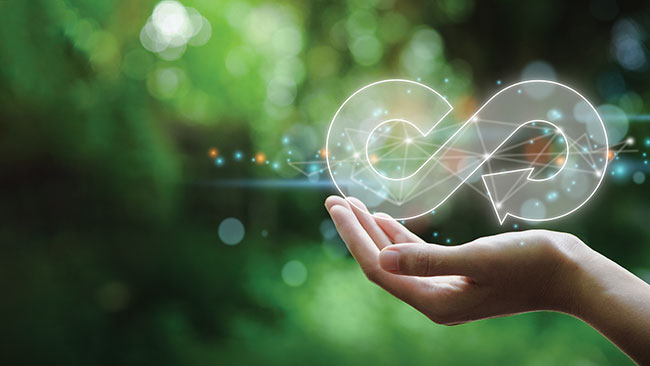
Features
Business
Production
Circular economy is business 3.0
It is time for the cannabis industry to take note of an alternative packaging method: reduce-reuse-repair.
December 2, 2022 By Mika Unterman
 A circular packaging model, where plastics in cannabis are reused before they are recycled, has the potential to save money and improve margins.
Photo: Deemerwha studio/Adobe stock
A circular packaging model, where plastics in cannabis are reused before they are recycled, has the potential to save money and improve margins.
Photo: Deemerwha studio/Adobe stock We live in a take-make-waste society. We extract materials from the earth in a damaging way, we consume huge amounts of energy, water, and other materials to create a product that we want, and generally anticipate using it only once.
Regulators across North America are starting to take action around the issue of single use plastics. The Canadian government, for example, recently announced they will ban common single use plastics — checkout bags, plastic cutlery, six pack rings, straws — thereby eliminating an estimated 1.3-million tonnes of hard-to-recycle plastic waste.
In the U.S., states like California have also recently passed laws to reduce plastic, increase recycling and shift the economic burden of waste disposal to plastic producers and packagers. Even cannabis regulators are starting to implement change. For example, Vermont now has a requirement that cannabis consumer packaging must be reusable.
Prioritizing environmental issues is becoming increasingly critical for companies across all industries, and the cannabis industry likely uses more than its fair share of single use plastics.
In an already environmentally taxing industry — what some have dubbed a “climate villain” — shifting to more sustainable practices is a necessity.
It’s my view, as a practitioner of sustainability and social impacts in the cannabis space, that the industry needs to face these issues head on, and transition from that “take-make-waste” system to a circular economy model.
Breaking down a circular economy
Circular economies intend to eliminate waste and circulate materials at the highest value, which means reusing and repairing several times before we ever need to recycle.
When we live in a circular economy, the approach shifts to “reduce-reuse-repair,” where circular packaging products are designed to be reused. There are many models around circular packaging, including both consumer and corporate ownership, and case studies from corrugated cardboard to aluminum bottles led by global companies like Pantene and ZeroBox.
We use a lot of plastics in the cannabis industry and the majority is intended to be disposed of after a single use. While some of the packaging conversation has focused on using recyclable materials, which is a necessary part of a circular economy, it shouldn’t be relied on as our primary initiative towards sustainability.
Recycling products that have only been used once is not the most efficient use of that material, especially a plastic or glass container for cannabis. Also, consider that the track record of efficiency in recycling isn’t overly optimistic — 40 per cent of plastics are mismanaged. This means that after they make it to the recycling facility many plastics are then taken to landfill.
We also lose a lot of material as part of the recycling process. To create one jar of recycled plastic, 2.2 jars will need to be recycled. Recycling has a low material conversation rate, but when you are able to reuse that jar, you are able to retain 100 per cent material conversion.
Are there alternatives?
Others might say the answer is found in the transition to hemp plastics or compostable plastics, but I’m not convinced.
Despite the fact that bio-based (made from organic material such as hemp) and compostable (degrading within a specific timeframe) materials are often championed as the solution to our industry’s plastic waste problem, a similar issue remains: both of these solutions are still single use.
It’s also important to consider that biobased plastics such as hemp plastics are often touted as biodegradable, which they are before they are mixed with resin.
The carbon sink created by the organic material growing is negated by the carbon footprint of the production process. And compostable plastics, despite being biodegradable, will often end up in landfill as consumers don’t always have the knowledge or confidence to know which plastics can go into the compost.
When biodegradable plastics end up in a landfill, they procedure eight times the amount of methane (more harmful than CO2) than traditional plastics in a landfill.
Plastics are incredibly durable and can withstand anywhere from 50-80 uses.
While there are clear environmental benefits of shifting to a circular model, we also know that environmental justifications, such as drastically reducing the manufacturing footprint or the rate of petroleum extraction, won’t convince everyone alone. And the strict cannabis packaging regulatory environment often closes the door to exploring alternatives.
There are also direct cost savings alongside relatively little-to-no lift for businesses to make the change. Collecting and sanitizing the packaging already in use by manufacturers represents a huge potential for cost savings.
As our sector faces mass layoffs, from cultivation to tech, and as the industry seeks to “rightsize” their businesses, a circular packaging model has the potential to save money and improve margins.
Mika Unterman has been commercializing cannabis products since 2018, with 60 brought to market to date. Since founding Apical Ethical Cannabis Collective in 2019, she’s made it her mission to work with companies, demonstrating how sustainability can support profitability.
Print this page